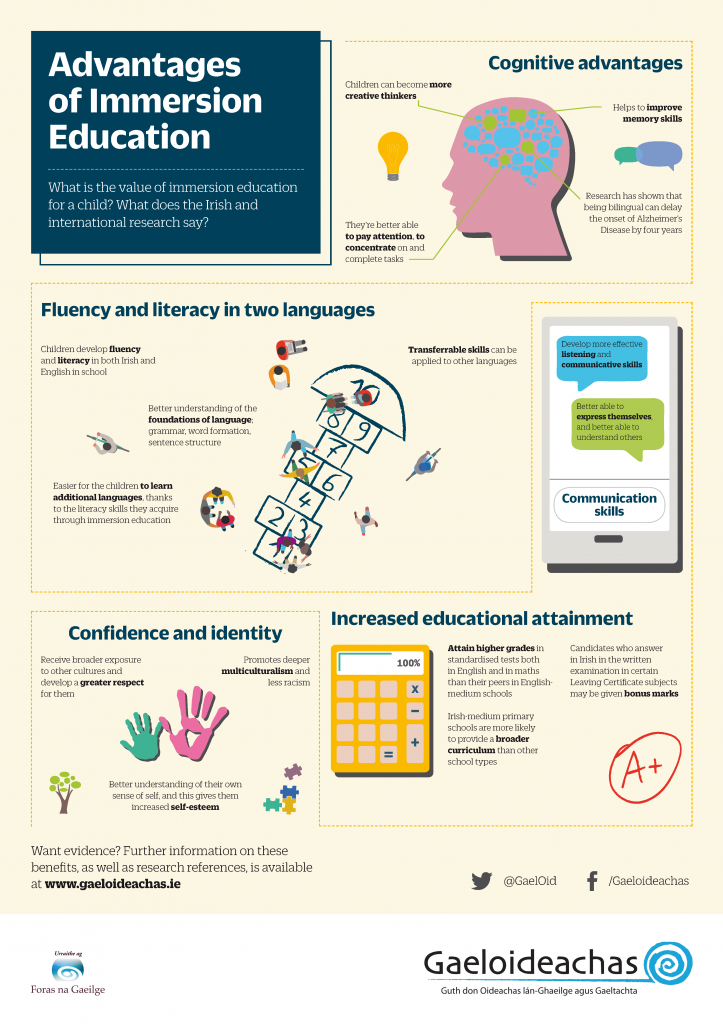No. You can do a lot to encourage your child to become fluent in Irish without being able to speak the language yourself. The majority of children in Irish-medium schools do not have Irish as one of their home languages.
The best way to help your child in post-primary school is to show them that you are positive about them going to school and becoming fluent in Irish. Letting your child know that you are proud of them, that you’re interested in what they’re doing in school and that you’re excited to learn along with them will be a big help to them.
Resources:
The following resources may help you on your way towards making your decision.
Below is a list of Irish language programs on the RTÉ Player, mostly for kids, which is a great way to start to learn.
https://www.rte.ie/player/find?q=gaeilge
Below is a link to Learning Irish with Liam Ó Maonlaí as created by the Irish Independent many years ago.
https://www.youtube.com/watch?v=Bf9mIckJGV4&list=PL2D6CDB968FB72FA5
Be Enthusiastic
Show your child that you’re excited about them starting in school. Enrolling them in the school was a big decision for you, especially if you don’t have fluent Irish yourself. Read up on the benefits of education through Irish and remind yourself why you chose the school for them.
Talk Together
Talking to your child in any language helps them to improve their communication skills. It’s how we learn to talk in the first place, and it’s how they’ll learn to speak Irish when they start in school, by listening to their teachers and then imitating them.
Talk to your child about all the great things that will happen when they start school school: making new friends, playing games, reading new books, singing songs and learning a whole new language. Give them the chance to tell you what they’re looking forward to or what they might be worried about.
Talk to them about the language or languages you use at home, and explain to them that they will use Irish in school. Help your child to understand that there are different languages. From the age of about 2, children can tell the difference between colours and shapes, and they begin to develop an awareness of the differences between people. Talk to them about how language is one of the ways in which people can be different, and that this can be fun and exciting. Use examples that will be familiar to your child if you can, friends and neighbours who speak other languages, or any experiences they have of other countries and cultures. Try watching some cartoons in Irish together. There’s a huge range of programmes and interactive games in Irish available on www.cula4.com, TG4’s player for children’s television.
Introducing some Irish to your home before your child starts in school will help them to get used to how the language sounds, and even to learn a few simple words. Gaeloideachas has published a book of simple vocabulary and phrases to help parents to use some Irish at home. It covers various everyday themes: home life, school, animals, colours, clothes, and lots more besides. It’s available to download here. You can listen to how the words are pronounced through the online dictionary www.focloir.ie.
Read Together
The very best thing you can do for your child to prepare them for school is to read to them, and foster a love of books and reading. Picture books are a great way to encourage conversation – about school or anything else. Read in your home language, or if you have a cúpla focal, try reading a simple book in Irish with them. Make an adventure of it, take a trip to the library together and allow your child to choose a book for you to read.
Learn Together
The vast majority of parents whose children go to a Gaelscoil don’t have fluent Irish. Show your child that you’re interested in learning along with them and they’ll be motivated to teach you. There’s no better teacher than the child who comes home from school every day, excited to share what they’ve learned. Take a look at www.irishforparents.ie. This website has simple lessons to help you to learn Irish yourself at home, as well as a number to call when you need help with your child’s homework. Ask your school about classes for parents. Many schools offer them at low cost and convenient times throughout the school year. These classes give you a great chance to talk to other parents about their experiences and to trade tips on how best to support your child.
Don’t worry!
It’s natural to be anxious about your child starting school, even more so when they’ll be learning through a language that you’re not fluent in yourself. But don’t forget that the teachers, special needs assistants and all the support staff in Gaelscoileanna welcome new children in every year. It’s their job to take the very best care of your child, and to help them to settle and feel happy in school. They have all kinds of tricks up their sleeves to do this – songs, body language, gestures, pictures, rhymes, repetition – to make sure that the children can understand them and that they can understand the children. It won’t be long before your child will start using the Irish they pick up in school, and they’ll be keen to teach you as they learn themselves.
Irish-medium schools recognise the importance of engaging parents in all aspects of their child’s learning, including homework. Teachers are aware that many parents may not speak Irish and homework is designed to reinforce what the student has already covered during school hours.
Your child will be able to explain the homework they’ve been given in the language you speak together at home. It will help your child a lot if you show them that you’re very interested in how they are becoming fluent in Irish, and in the progress they’re making at school.
Use it as an opportunity to learn along with them.
Irish-medium schools routinely provide education for students with special needs, both physical and educational; students with impaired sight or hearing, autism spectrum disorders, dyslexia and other special educational needs. Irish-medium schools offer the same supports for these students as English-medium schools do.
Immersion education does no harm to students who have special educational needs and a report from the National Council for Special Education published in 2011 recognised that bilingual education contributes to students’ social, emotional and interpersonal growth.
Children showing learning difficulties in language (such as Dyslexia) are offered similar supports that a child in a Special Reading school would get. The Special Education Team work with the class teachers to cater for the children’s specific learning needs and create learning plans in consultation with parents.
In Gaelscoil na Lochanna, children get access to the TTRS (Touch Type Read Spell) programme and this is used alongside other programmes such as Toe by Toe, Alpha to Omega, SNIP, and the PAT programmes. Our model of Special Education has received high praise from School Psychologists.
Irish-medium immersion education has a positive effect on students’ fluency in English, rather than a negative one. Students’ abilities in other languages (including English) is helped rather than hindered. Parents need not worry about the students’ ability should they choose to continue study at third level, as the skills the students develop at post-primary level are transferrable to their third-level education. Students do not have difficulty getting to grips with terminology in English as they have already developed an understanding of the concepts required to study the subject.
There are many reasons why you might choose to educate your child in a Gaelscoil.
- Your child will learn Irish through various methods of education; music, play, gestures, rhymes, etc. They will enjoy learning the language and will be proud to speak it.
- International research shows, quite clearly, that being bilingual helps both intellectual and cognitive development.(see graphic below)
- Children who speak Irish develop an understadning of their own cultural identity, both as Irish citizens and as Europeans.
- Speaking a ‘minority language’ can develop a healthy respect, in your child, for other races and cultures.

Resources
Immersion education, in a Gaelscoil setting, is where the children receive their education, both inside and outside the classroom setting, through the medium of Irish.
Cognitive Benefits
Immersion education leads to greater cognitive flexibility and divergent thinking; this means that students become more creative thinkers, with the ability to provide a range of valid solutions to a problem. All Irish and international research shows that the sooner a child becomes bilingual, the greater the cognitive benefits.
Immersion education leads to increased attentional control and enhanced executive control; this means that students are better at paying attention, focusing on and completing tasks, listening and communicating. They have better memory skills, are better at responding to situations and making reasonable decisions and are more secure in their decision-making.
Additionally, research shows that bilingualism can delay the onset of Alzheimer’s by up to 4 years!
Communicative Benefits
Parents need not worry that their children will not understand their teacher. The immersion model supports children’s language acquisition through total absorption and involvement, it is not a “sink-or-swim” approach. Though teachers will speak in Irish to the children from the very first day, they will use body language, pictures and tone of voice to make sure that the children understand them. Children will at first reply in their home language, but quickly learn to speak Irish to their teacher and their classmates.
Children for whom neither Irish nor English is a home language benefit from immersion education and it will benefit rather than hinder their acquisition of English. Supports for children for whom English is an additional language are available in Irish-medium schools just as they are in other schools.
Students’ ability in other languages (including English) increases rather than decreases with immersion education. Languages share the same cognitive process; concepts and skills acquired in one are transferred to the other and are processed in either language since both are interactive.
Increased Tolerance & Self-Esteem
Immersion education fosters higher levels of tolerance amongst children. Students have a broader exposure to and appreciation of the value of various cultures, this leads to deeper multiculturalism, greater tolerance and less racism. Bilingualism gives them a greater sense of identity and increases their self-esteem.
Academic Benefits
Children gain a better understanding of the foundations of language – grammar, word formation, sentence order – through immersion education, and they gain transferable skills that help them to learn other languages.
Students in Irish-medium schools have higher achievement in both English and Maths than their peer groups in English-medium schools. Irish-medium schools are also more likely to provide a broader curriculum than other school types.
Supporting Students with Special Educational Needs
The same supports are made available to children with special educational needs (SEN) in Irish-medium schools and they enjoy the same benefits of bilingual education. Irish-medium schools routinely cater for children with physical and intellectual disabilities; sight and hearing difficulties, Autism spectrum disorders, dyslexia, and other SEN. Some Irish-medium schools are now being granted special units to cater for children with additional needs.
Bilingual education for children with SEN ‘does no harm and clearly does contribute to social, emotional and interpersonal growth’ – NCSE Report, 2011
